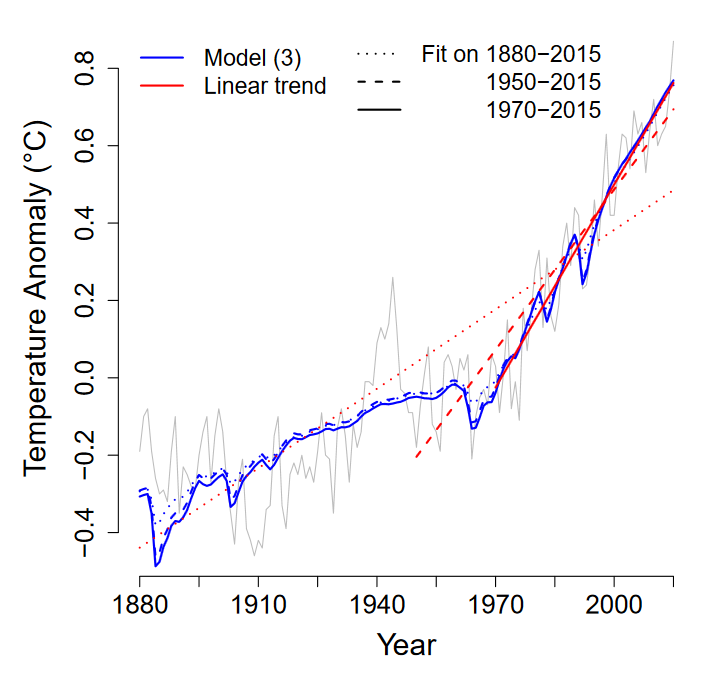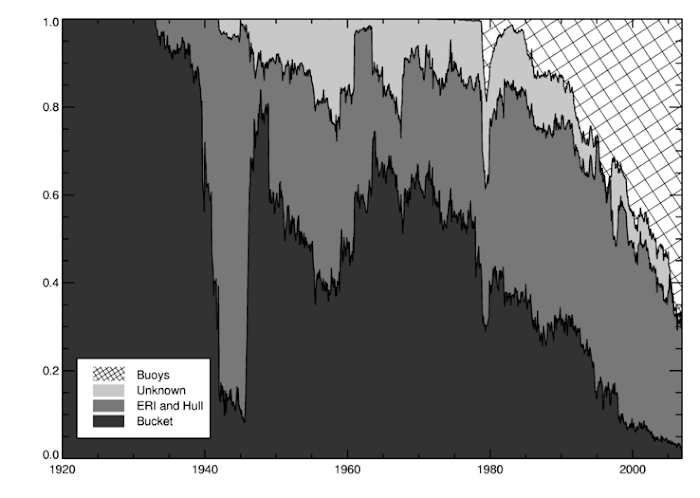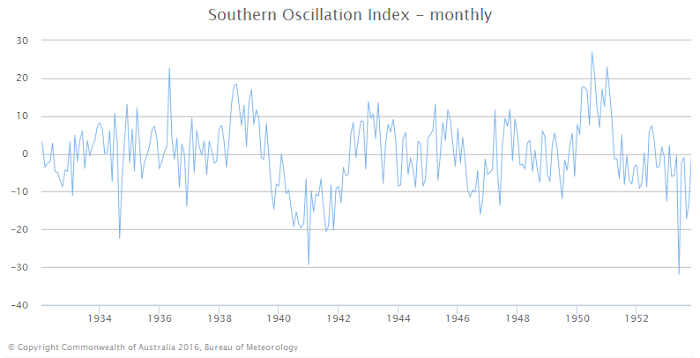Naïve empiricism and what theory suggests about errors in observed global warming
This is a re-post from Variable Variability
In its time it was huge progress that Francis Bacon stressed the importance of observations. Even if he did not do that much science himself, his advocacy for the Baconian (scientific) method, gave him a place as one of the fathers of modern science together with Nicolaus Copernicus and Isaac Newton.
However, you can also become too fundamentalist about empiricism. Modern science is characterized by an intricate interplay of observations and theory. An observation is never free of theory. You may not be aware of it, but you make theoretical assumptions about what you see in any observation. Theory also guides what to observe, what kind of experiments to make.
Charles Darwin often claimed to adhere to Bacon's ideals, but he had another side. University of California professor of biology and philosophy Francisco Ayala writes in Darwin and the scientific method:
“Let theory guide your observations.” Indeed, Darwin had no use for the empiricist claim that a scientist should not have a preconception or hypothesis that would guide his work. Otherwise, as he wrote, one “might as well go into a gravel pit and count the pebbles and describe the colors. How odd it is that anyone should not see that observation must be for or against some view if it is to be of any service”
But his ambivalence is seen in Darwin's advice to a young scientist:
Let theory guide your observations, but till your reputation is well established be sparing in publishing theory. It makes persons doubt your observations.
The same ambivalence is seen in Einstein. Mitigation skeptics like this quote:
No amount of experimentation can ever prove me right; a single experiment can prove me wrong.
The quote this when the observations show less changes than the model. If the observations show more changes than the model/theory the observations, they quickly forget Einstein and the observations are suddenly wrong.
In practice Einstein was more realistic. Prof in molecular physics [[John Rigden]] wrote in his book about Einstein's wonder year 1905: "Einstein saw beyond common sense and, while he respected experimental data, he was not its slave."
That is perfectly reasonable. When theory and observations do not match, the theory can be wrong, the observations can be wrong and the comparison can be wrong. What is called observations is nearly always something that was computed from observations and also that computation can be imperfect. Only when we understand the reason, can we say what it was.
The main blog of the mitigation skeptical movement, WUWT, on the other hand is famous for calling trying to understand the reasons for discrepancies: "excuses".
Global mean temperature
That was a long introduction to get to the graph I wanted to show, where theory suggests the global mean temperature estimates in some periods may have problems.
The graph was compute by Andrew Poppick and colleagues and it looks as if the manuscript is not published yet. They model the temperature for the instrumental period based on the known human forcings — mainly increases in greenhouse gasses and aerosols (particles from combustion floating in the air) — and natural forcings — volcanoes and solar variations. The blue line is the model, the grey line the temperature estimate from NASA GISS (GISTEMP).

The fit is astonishing. There are two periods, however, where the fit could be better: world war II and the first 40 to 50 years. So either the theory (this statistical model) is incomplete or the observations have problems.
It is expected that the observations in the WWII are more uncertain. Especially the sea surface temperature changes are hard to estimate because the type of ships and thus the type of observations changed radically in this period. The HadSST estimate of the measurement methods is shown below. During WWII American war ships dominated and they mainly used Engine Room Intake observations, whereas before and after the war merchant ship would often measure the temperature of a bucket of sea water.

The figure above are the observational methods estimated by the UK Hadley Centre for HadSST. Poppick's manuscript uses GISTEMP. Its sea surface temperature comes from ERSST v4. (The land data of GISTEMP comes from the stations gathered by NOAA (GHCNv3) and additional Antarctic stations).
ERSST estimates the observational methods of ships by comparing the sea surface temperature to the night marine air temperature (NMAT). This relationship is only stable over larger areas and multiple years. They can thus not follow the fast changes in the WWII observational methods well.
Also for HadSST it is not clear whether these corrections are accurate and they are large: in the order of 0.3°C. What makes this assessment more difficult is that in the beginning of WWII there was a strong and long [[El Niño event]]. Thus a bit of a peak is expected, but it is not clear whether the size is right.
I would not mind if a reviewer would request to add a statistical model that includes El Nino as predictor in Poppick's paper. That would reduce the noise further (part of the remaining noise is likely explained by El Nino) and that would make it easier to assess how well the temperature fits in the WWII.

The Southern Oscilation Index (SOI) of the Australian Bureaux of Meteorology (BOM). Zoomed in to show the period around WWII. Values below -7 indicate El Nino events and above +7 La Nina events.
It would be an important question to resolve. The peak in the WWII is a large part of the hiatus (a real one) we see in the period 1940 to 1980. If you think the peak in the 1940s away, this hiatus is a lot smaller. The lack of warming in this period is typically explained with increases in aerosols. It ended when air pollution regulations slowed the growth of aerosols; especially in the industrialised air quality improved a lot. I guess that if this peak is smaller, that would indicate that the influence of aerosols is smaller than we currently think.
While the observations hardly showed any warming the first 40 to 50 years, the statistical model suggests that there should have been some warming. The global climate models also suggest some warming. And also several other climate variables suggest warming: the warming in winter, the time lakes and rives freeze and break up, the retreat of glaciers, temperature reconstructions from proxies, and possibly sea level rise. See for example this graph of the dates rivers and lakes froze up and broke up.

I wrote about these changes in my previous post on "early global warming". Poppick's statistical model adds another piece of evidence and suggests that we should have a look whether we understand the measurement problems in the early data well enough.
By comparing the observations with the statistical model we can see periods in which the fit is bad. Whether the long-term observed trend is right cannot be seen this way because the statistical model would still fit well, just with a different coefficient for the long-term forcings. This relationship is likely biased in a similar way as the simple statistical models used to estimate the equilibrium climate sensitivity from observations. This model, and thus theory, does provide a beautiful sanity check on the quality of the observations and suggests periods which we may need to study better.
Posted by Guest Author on Tuesday, 23 August, 2016



